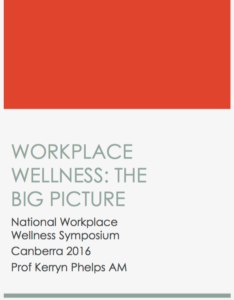Transparency is extremely important to us, so we are letting you know that we may receive a commission on some of links you click on from this page. See our disclaimer.
We recently reported on a presentation by the former president of the Australian Medical Association Dr. Kerryn Phelps at the National Workplace Wellness Symposium in Canberra, Australia last month.
Among other topics, Dr. Phelps argued that strong workplace wellness program serve as an effective method to recruit and retain good employees.
 We wanted to further highlight aspects of her full presentation, titled “Workplace Wellness: The Big Picture,” which can be found here.
We wanted to further highlight aspects of her full presentation, titled “Workplace Wellness: The Big Picture,” which can be found here.
Dr. Phelps noted key trends from the Global Wellness Institute report “The Future of Wellness at Work.” Highlights include:
- “Companies must adopt a culture of wellness as the default, not the exception, if they want to attract and retain good people.”
- “Companies will recognize that doing right by employees and the community is good business.”
- “Governments will become more aggressive about mandating wellness, including in the workplace.”
- “The healthiest workplaces will be a destination where people go to improve their own wellness.”
She added that wellness and work are “interdependent” and that common workplace health issues include:
- Physical inactivity
- Poor nutrition habits
- Fatigue
- Stress / burnout/ anxiety / depression Chronic disease
- Injury
And for a workplace wellness program to be effective, they must address various challenges, including;
- “Participation rates lukewarm to variable”
- “Results often poorly documented or intangible”
- “Levels of accountability unclear”
- “Screening may be untargeted or unnecessary”
- “Privacy intrusion”
- “Employees have existing health problems preceding or unrelated to their employment”
- “Wellness programs my not be feasible for SME”
- “Wellness programs are not a substitute for an ‘unwell' workplace culture”





0 Comments